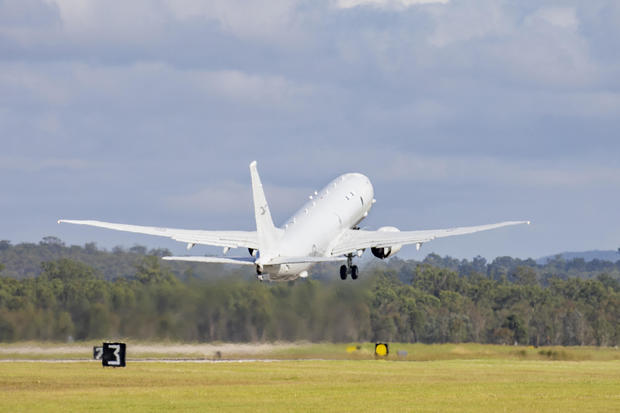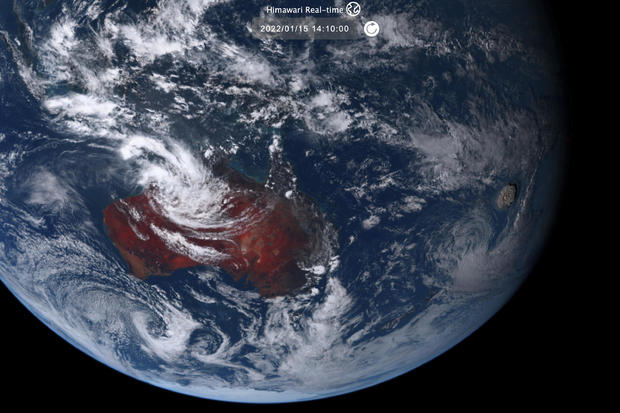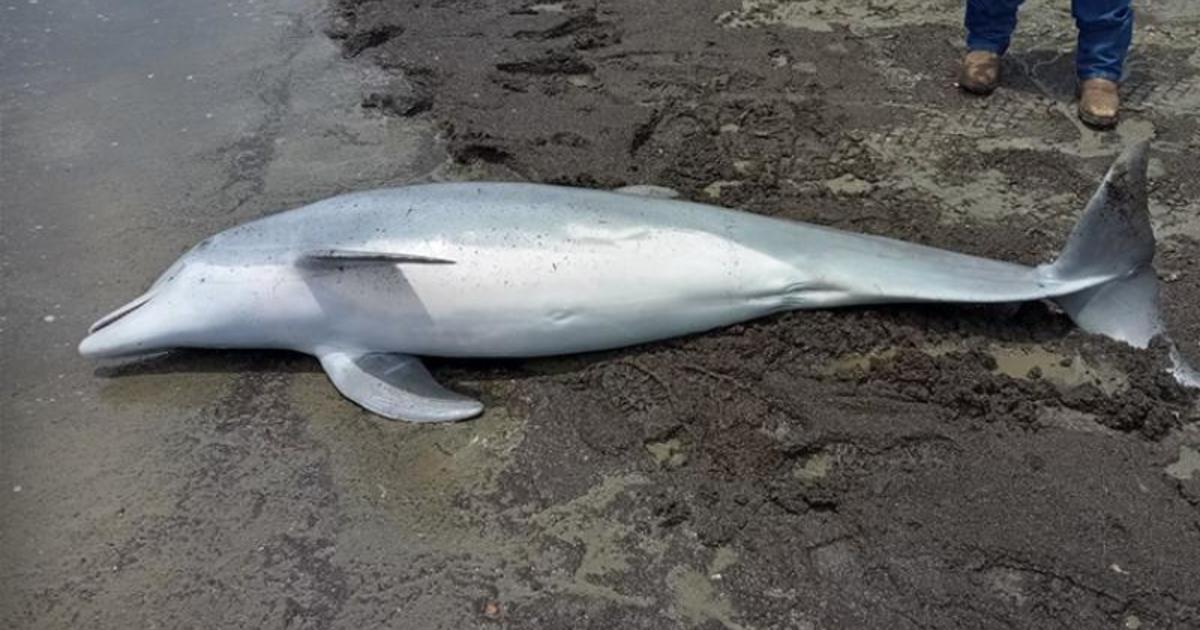Surveillance flights finally getting to view damage to Tonga from eruption of huge undersea volcano
Wellington, New Zealand — New Zealand and Australia were able to send military surveillance flights to Tonga on Monday to assess the damage a huge undersea volcanic eruption left in the Pacific island nation.
A towering ash cloud since Saturday's eruption had prevented earlier flights. New Zealand hopes to send essential supplies, including much-needed drinking water, on a military transport plane Tuesday.
A British woman who was missing has been found dead, her family said, in the first reported fatality on Tonga.
The brother of Angela Glover, who ran an animal rescue center, said the 50-year-old died after being swept away by a wave.
Nick Eleini said his sister's body had been found and that her husband survived.
New Zealand Prime Minister Jacinda Ardern said the capital, Nuku'alofa, was covered in a thick film of volcanic dust, contaminating water supplies and making fresh water a vital need.
Aid agencies said thick ash and smoke had prompted authorities to ask people to wear masks and drink bottled water.
Communications with Tonga remained extremely limited. The company that owns the single underwater fiber-optic cable that connects the island nation to the rest of the world said it likely was severed in the eruption and repairs could take weeks.
The loss of the cable leaves most Tongans unable to use the internet or make phone calls abroad. Those who have managed to get messages out described their country as looking like a moonscape as they began cleaning up from the tsunami waves and volcanic ash fall.
Tsunami waves of about 2.7 feet crashed into Tonga's shoreline. The waves crossed the Pacific, drowning two people in Peru and causing minor damage from New Zealand to Santa Cruz, California.
Tsunami advisories issued Saturday for the entire U.S. West Coast and Alaska have since been lifted.
Despite warnings from officials to stay away from Northern California beaches, rescue crews pulled five people to safety after they ventured too close to ocean waters churned up by the surge from Saturday's tsunami, CBS San Francisco reported.
One complicating factor to any international aid effort is that Tonga has so far managed to avoid any outbreaks of COVID-19. Ardern said New Zealand's military staff were all fully vaccinated and willing to follow any protocols established by Tonga.
Dave Snider, the tsunami warning coordinator for the National Tsunami Warning Center in Palmer, Alaska, said it was very unusual for a volcanic eruption to affect an entire ocean basin, and the spectacle was both "humbling and scary."
The U.S. Geological Survey estimated the eruption caused the equivalent of a magnitude 5.8 earthquake. Scientists said tsunamis generated by volcanoes rather than earthquakes are relatively rare.
The United Nations Secretary General's Special Envoy for Oceans, Peter Thomson, told CBS News countries were mobilizing support for Tonga and the nearby archipelago of Fiji. "The volcanic eruption is a dramatic reminder we live within nature's embrace."
Thomson, who was Fiji's Ambassador to the U.N., told CBS News' Pamela Falk, "Our thoughts and sympathies are with the people of Tonga and South East Fiji."
"Stay strong," he urged their residents.
Thomson has advocated for aid for Fiji and other small states to mitigate the impact of climate change.
Scientists said they didn't think the eruption would have a significant impact on the Earth's climate.
Huge volcanic eruptions can sometimes cause temporary global cooling as sulfur dioxide is pumped into the stratosphere. But in the case of the Tonga eruption, initial satellite measurements indicated the amount of sulfur dioxide released would only have a tiny effect of perhaps 0.02 degrees Fahrenheit global average cooling, said Alan Robock, a professor at Rutgers University in New Jersey.
Satellite images showed the spectacular undersea eruption Saturday evening, with a plume of ash, steam and gas rising like a giant mushroom above the South Pacific waters.
A sonic boom could be heard as far away as Alaska and sent pressure shockwaves around the planet twice, altering atmospheric pressure that may have briefly helped clear out the fog in Seattle, according to the National Weather Service. Large waves were detected as far away as the Caribbean due to pressure changes generated by the eruption.
Samiuela Fonua, who chairs the board at Tonga Cable Ltd. that owns the single cable that connects Tonga to the outside world via Fiji, said the cable appeared to have been severed about 10 to 15 minutes after the eruption. He said the cable lies atop and within coral reef, which can be sharp.
Fonua said a ship would need to pull up the cable to assess the damage and then crews would need to fix it. A single break might take a week to repair, he said, while multiple breaks could take up to three weeks. He added that it was unclear yet when it would be safe for a ship to venture near the undersea volcano to begin the work.
A second undersea cable that connects the islands within Tonga also appeared to have been severed, Fonua said. However, a local phone network was working, allowing Tongans to call each other. But he said the lingering ash cloud was continuing to make even satellite phone calls abroad difficult.
He said Tonga, home to 105,000 people, had been in discussions with New Zealand about getting a second international fiber-optic cable to ensure a more robust network but the nation's isolated location made any long-term solution difficult.
The cable also broke three years ago, possibly due to a ship dragging an anchor. At first Tongans had no access to the internet but then some limited access was restored using satellites until the cable was repaired.
In a video posted on Facebook, Nightingale Filihia was sheltering at her family's home from a rain of volcanic ash and tiny pieces of rock that turned the sky pitch black.
"It's really bad. They told us to stay indoors and cover our doors and windows because it's dangerous," she said. "I felt sorry for the people. Everyone just froze when the explosion happened. We rushed home." Outside, people were seen carrying umbrellas for protection.
Rachel Afeaki-Taumoepeau, who chairs the New Zealand Tonga Business Council, said she hoped the relatively low level of the tsunami waves would have allowed most people to get to safety, although she worried about those living on islands closest to the volcano.
"We are praying that the damage is just to infrastructure and people were able to get to higher land," she said.
The explosion of the Hunga Tonga Hunga Ha'apai volcano, about 40 miles north of Nuku'alofa, was the latest in a series of dramatic eruptions. In late 2014 and early 2015, eruptions created a small new island and disrupted international air travel to the Pacific archipelago for several days.
Earth imaging company Planet Labs PBC had watched the island in recent days after a new volcanic vent began erupting in late December. Satellite images showed how drastically the volcano had shaped the area, creating a growing island off Tonga.





